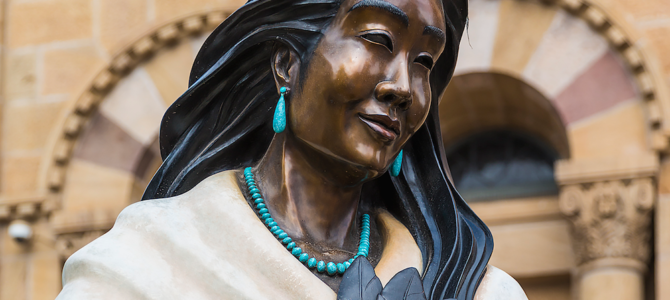
Leftist activism originally in protest of police brutality against black Americans has significantly expanded its focus to include historical and contemporary abuse of indigenous peoples.
Mobs across California have defaced and removed statues of 18th-century Spanish Franciscan missionary Junipero Serra on the absurd charge that the man who tirelessly labored to protect American Indians represents “hate, bigotry, and colonization.” Monuments to explorer Christopher Columbus, also censured for his mistreatment of indigenous communities in the Caribbean, are also coming down.
The Washington Redskins football franchise, under intense pressure from politicized capitalists, have begun what experts are calling an inevitable process to change their name and mascot. Cleveland’s baseball team, the Indians, is also considering a name change.
Contemporary conversations about America’s complex relationship with American Indian peoples casually employ the buzzwords of progressivist, Zinnian historical revisionism: oppression, brutalization, colonization, land theft, ethnocide, etc. Yet any complete consideration of that chapter of American history must also take account of the unfortunate fact that all these words could also be applied to American Indians’ treatment of one another.
The story of St. Kateri Tekakwitha, an Algonquin-Mohawk whom the Catholic Church honors today and who is the first Native American saint, illuminates that complicated past.
Who Was St. Kateri?
Kateri was the daughter of a Mohawk chief and an Algonquin, Catholic woman, Kahenta, who had been captured in a raid. That women were routinely stolen from their families and forced to marry men of enemy tribes is itself a disturbing, overlooked reality in contemporary portrayals of American Indians as peaceful and harmonious until the evil white man arrived and forced them into battle. The truth is far more dangerous and deadly.
Tribes in what is now the northern United States and southern Canada were constantly at war with one another. The Iroquois Confederacy, with the help of superior Dutch and English arms, drove the Algonquins and other tribes from their lands.
A Mohawk war party in 1647 attacked and practically exterminated an Algonquin community. The Iroquois, who practiced both slavery and cannibalism, routinely tortured to death captured enemy warriors. Kateri witnessed the torturing of Mohican warriors who had attacked her Mohawk village in 1669.
Kateri’s was a difficult life in other ways, as well. She contracted smallpox at age four, which permanently scarred her skin. Her mother and father both died from the smallpox outbreak, and she was raised by an uncle. At age 19, she was baptized on Easter Sunday, April 18, 1676, taking the name Kateri in honor of St. Catherine of Siena.
Kateri resisted family efforts to persuade her to marry and suffered ridicule and mistreatment because of it. She declared: “I have consecrated myself entirely to Jesus, son of Mary, I have chosen Him for husband and He alone will take me for wife.” She eventually fled to a Christian community near Montreal.
French priests were impressed with Kateri’s courageous willingness to suffer, which she offered for the religious conversion of her people. She lived only until age 23, dying from poor health. Her last words were, “Jesus, Mary, I love you.”
A number of miracles have been associated with her since her death in 1680. St. Kateri Tekakwitha was canonized by Pope Benedict XVI on Oct. 21, 2012, and is considered the patroness of ecology and the environment, people in exile, and Native Americans. Statues honoring her can be found across the United States, including New York, New Jersey, Pennsylvania, Ohio, Arkansas, South Dakota, and New Mexico. She is also widely venerated in Canada and Mexico.
Many might find it strange that so much praise and honor is lavished upon an American Indian girl who died so young and, from a certain vantage point, seemed to have so little impact. Yet that misses the point. St. Kateri is memorialized precisely because of her innocence, purity, and devotion at a time of great violence and upheaval among American Indians in the northeastern United States. Certainly European colonial powers receive credit for much of that turmoil, but cruelty long predates the white man’s entrance into America.
History Is Complicated
Indeed, as I’ve noted in previous articles at The Federalist, Aztec and Mayan civilizations in what is present-day Mexico slaughtered hundreds of thousands of people, typically captured from conquered tribes, in brutal rituals of human sacrifice to appease their gods. The Mississippians, a 12th-century civilization in what is now Illinois, conquered neighboring tribes and took their land.
In “War Before Civilization: the Myth of the Peaceful Savage,” professor of archaeology Lawrence H. Keeley catalogues the manifold violence of pre-colonial America. In Canada, Dogrib Indians massacred the Yellowknives tribe into oblivion. A mass grave at Crow Creek in South Dakota contains the remains of more than 500 men, women, and children who were slaughtered, scalped, and mutilated during an attack on their village in approximately 1325 A.D. Survivors of the attack were primarily young women who were taken as captives.
To state the obvious, history is complicated because humans are complicated. Rarely if ever in the many millennia of human civilization has there been a people group who has not committed some atrocity. American Indians are no exception.
Indeed, tribes in the American southeast in the 18th and 19th centuries managed plantations that “rivaled those of their white neighbors.” In 1860, citizens of the Cherokee, Choctaw, Cree, and Chickasaw tribes owned more than 5,000 black slaves. So much for simplistic narratives about the white, European oppression of American Indians and people of color.
Certainly the United States has an obligation to right past wrongs, of which there are many, against indigenous peoples. But we also have an obligation to avoid superficial, Manichean portrayals of history that unnecessarily divide our nation and inflame ignorant ideologies of hatred and outrage.
“There can never be peace between nations until there is first known that true peace which is within the souls of men,” said Black Elk, a Lakota medicine man who was present at both the Battle of the Little Bighorn and the massacre at Wounded Knee. Later in life, he converted to Catholicism and became a renowned catechist.
He, too, is being considered for sainthood. The humble, pious, and patient witness of St. Kateri Tekakwitha and Black Elk offer a better way of overcoming our national distemper, one marked by love, forgiveness, and truth.









